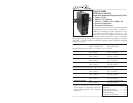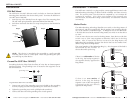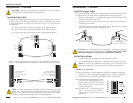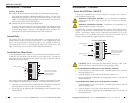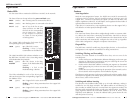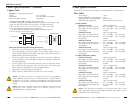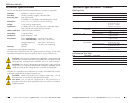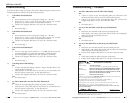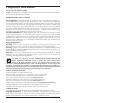
8
SISTF10xx-130-LR(T)
24-hour Technical Support: 1-800-260-1312 -- International: 00-1-952-941-7600
Operation
Status LEDs
Use the status LEDs to monitor the SISTF10xx-130-LR(T) in the network.
The three LEDs near the top indicate the power and fault status:
PWR1 (amber) on = Primary power is connected to device.
PWR2 (amber) on = Backup power is connected to the device.
FAULT (red) on = If any of the five (5) port
alarm switches are “on“ and
the link on the corresponding
port is inactive (ex: switch 3
is “on” and port 3 is inactive);
or if there is a loss of primary
or backup power
The “100M” LEDs indicate the link status of the
corresponding fiber port (100Base-FX):
100M (green) on = Fiber link is active.
flashing = Data is being
transmitted over the fiber link.
The “RING MASTER” LED indicates whether or not
the SISTF10xx-130-LR(T) is the current Ring Master
of the Redundant Ring network:
RING (green) on = The device is the Ring
MASTER Master of the Redundant Ring
Network.
flashing = A link in the
Redundant Ring is broken.
The LEDs embedded in each of the RJ-45 ports
indicate the status of the corresponding copper link
(10/100Base-T/TX):
10M (green) on = Copper link is active at 10 Mb/s.
flashing = Data is being transmitted over the copper link
at 10 Mb/s.
100M (green) on = Copper link is active at 100 Mb/s.
flashing = Data is being transmitted over the copper link
at 100 Mb/s.
TX
TX
PWR 1
PWR 2
FAULT
Redundant Ring Industrial Switch
RX
RX
10/100BASE-TX
100BASE-FX
100M
100M
RING
MASTER
techsupport@transition.com -- Click the “Transition Now” link for a live Web chat.
9
AutoCross
The AutoCross feature allows either straight-through (MDI) or crossover (MDI-
X) cables to be used when connecting the SISTF10xx-130-LR(T) to devices
such as PLCs or workstations. AutoCross determines the characteristics of the
cable connection and automatically configures the unit to link up, regardless
of the cable configuration. (Requires no operator intervention.)
Operation -- Continued
Features
Auto-Negotiation
With the Auto-Negotiation feature, the SISTF10xx-130-LR(T) automatically
configures itself to achieve the best possible mode of operation over the
copper link. The device broadcasts its speed (10 Mb/s or 100 Mb/s) and
duplex capabilities (either full- or half-duplex) and negotiates the best mode of
operation between the two linked devices.
If the device is connected to a non-negotiating device over the copper link, it
will default to 10 Mb/s speed, half-duplex mode.
Plug-and-Play
The SISTF10xx-130-LR(T) models are plug-and-play devices, so that software
configuration is not required at installation or during maintenance.
Switching, Filtering, and Forwarding
Packets are either filtered or forwarded when they arrive at one of the
switched ports.
• Packets with source and destination addresses belonging to the same port
segment are filtered and constrained to one port (relieving the rest of the
network from the need to process them).
• Packets with a destination address to another port segment are forwarded
to the appropriate port, and are not sent to the other ports where it is not
needed.
• Packets that are used in maintaining the operation of the network (such as
the occasional multi-cast packet) are forwarded to all ports.
The Ethernet switch operates in the store-and-forward switching mode, which
eliminates bad packets and enables peak performance to be achieved when
there is heavy traffic on the network.
Switching and Address Learning
The Ethernet switch address table holds up to 1K node addresses, making it
suitable for use with large networks. The address tables are self-learning, so
that as nodes are added, removed, or moved from one segment to another, the
Ethernet switch automatically keeps up with new node locations. An address-
aging algorithm deletes the least-used addresses in favor of newer, more
frequently used addresses. To reset the address buffer, power down the unit
and then power it back up.



